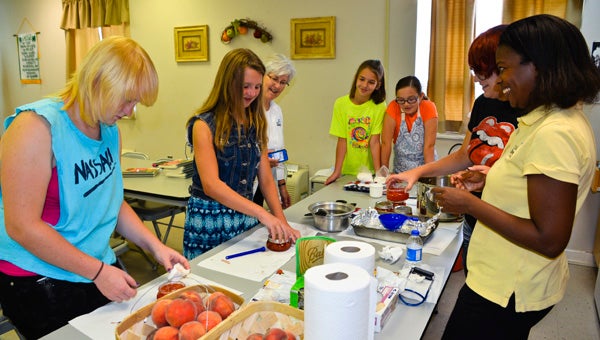4-H club members learn how to cook, can jam
Published 4:19 pm Tuesday, July 8, 2014

Morgan Champion (second from left) tightens the lid on her jar of peach jam she helped make during a canning workshop at the Chilton County Extension Office on Tuesday. Also pictured are (left to right) Racheal Carpenter, County Extension Coordinator Gay West, Cayleen Wakefield, Alexandra Cooper, Elizabeth Carpenter and Regional Extension Agent Janice Hall. Not pictured is Addie Cleckler.
Chatter in the Chilton County Extension Office’s kitchen ceased as members of the Peach Pals 4-H Club devoured warm biscuits smothered with peach jam they cooked and canned Tuesday morning.
Six club members participated in a canning workshop led by Janice Hall, Regional Extension Agent in Food Safety, Preservation and Preparation for the Alabama Cooperative Extension System.
“They did everything,” Hall said of the participants. “I just facilitated what to do.”
Hall provided step-by-step instructions for preparing the jam and properly canning it to preserve and protect it from bacteria growth.
“If you did not take it through this process and you put it in a jar and opened it three to four months later, you will find mold,” Hall said. “Mold can be toxic, and you don’t know what kind of mold it is. It only takes one time to get sick, and we don’t want that to happen.”
The group started by placing fresh peaches donated by Durbin Farms Market in hot water to make them easier to peel.
Then, they shocked the peaches by placing them in ice water so they could handle them and stop the cooking process, Hall said.
Next, they peeled off the skins, cut off bad spots in the flesh of each peach and took out the pits.
The group added lemon juice and fruit pectin (a soluble gelatinous polysaccharide used as a setting agent in jams and jellies) to the peaches and brought the mixture to a rolling boil for one minute in a large pot.
Then, they added sugar and boiled the dark orange mixture again for one minute.
Hall said the color of the peach flesh determines the color of the jam.
“The flesh of the peach is going to dictate what color jam you have,” Hall said. “The taste is going to be good regardless.”
They ladled the hot liquid into jars, skimmed foam off the jam’s surface for appearance, freed the bubbles in the jam and cleaned off the jar rims so the jars would seal properly before screwing the lids on tightly.
Hall said freeing the bubbles prevents air from discoloring the jam.
She provided participants with plastic tools designed to free bubbles but said a plastic knife could also be used.
Hall cautioned against using metal tools to free bubbles because metal tends to scratch jars and render them capable of breaking during the pressure canning process.
Next, they placed the jars in a water bath canner for five minutes.
Hall told the group to listen for a “pop” sound while removing the jars from the water.
“That sound means the jars have sealed,” she said. “It is a glorious sound. Sometimes, they pop in the canner, so you may not hear them pop.”
After taking the jars out of the steamy water and setting them on cloth pads to dry, the group ladled the leftover jam onto biscuits and sampled their creation.
“My most favorite part was probably all of it,” 12-year-old Alexandra Cooper said of the workshop. “It was amazing. I’ve canned before; I just never got to do all this.”
Cayleen Wakefield, 11, agreed between bites of jam-covered biscuit.
“You got to do it yourself,” she said of the whole process.
Each participant took home a jar of jam, “Home Food Preservation” book from ACES and a 2014 Chilton County Peach Festival Cook-Off booklet.
“It’s a life skill and an art that we would like to bring back,” Hall said of canning. “Just knowing the basics of where foods come from and how to preserve those foods is invaluable. They can take that knowledge and skill and pass it on to their children.”
The canning workshop Tuesday counted as one of the Peach Pals 4-H Club’s programs, which range in topics like cooking, sewing, beekeeping, music and art.
“We just do different programs like this,” 4-H Enrichment Coordinator Joan McGriff said.
Comprised of members ages 9-12, the club formed three years ago and meets at the Chilton County Extension Office once a month all year.
For more information, call (205) 280-6268 or visit Aces.edu/counties/Chilton.






